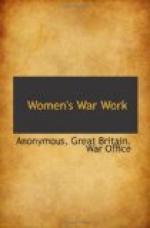Any woman who by working helps
to release a man or to equip a
man for fighting does national
war service. Every woman should
register who is able and willing
to take employment.
The forms were sent out in large numbers through the women’s societies of the country, and it was stated on them that women were wanted at once for farm-work, dairy work, brush-making, leather stitching, clothing, machinery and machining for armaments.
By next day the registrations were 4,000, mostly middle-class women, and in the first week 20,000 registered and an average of 5,000 a week after, but the mass of women who registered waited with no real lead or use of them for a long time. The Government seemed to suffer from a delusion a great many people have, that if you have enough machinery and masses of names something is being done, but you do not solve any problem by registers. You solve it by getting the workers and the work together.
The Government had not approached employers at first, but had left it to them entirely to take the initiative in this great replacement. This they had to a considerable extent done, using the Labour Exchanges and the other agencies and women were more and more quickly, steadily, ceaselessly replacing men.
The appeals for women for munition work were most swiftly responded to and educated women volunteered in thousands, as did working girls and women.
The question of assisting employment by fitting more women for commercial and industrial occupations was considered by the Government, and in October, 1915, the Clerical and Commercial Occupations Committee was appointed by the Home Office—a similar committee being set up for Scotland. It arranged with the London County Council and with local authorities that their Education Committees should initiate emergency courses all over the country for training in general clerical work, bookkeeping and office routine. The courses lasted from three to ten weeks, and the age of the students varied from eighteen to thirty-five.
Many free courses were inaugurated by business firms in large London stores, notably Harrods and Whiteleys, where their courses included all office and business training. Six week courses of free training for the grocery trade, for the boot trade, lens making, waiting, hairdressing, etc., were also given.
Our woman labor has been found to be quite mobile and girls have moved in thousands from one part of the country to another, and the munition girl travelling home on holiday on her special permit is a familiar figure.




